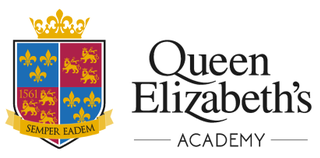
Horncastle is a market town and civil parish in the East Lindsey district in Lincolnshire, England. It is 17 miles (27 km) east of Lincoln. Its population was 6,815 at the 2011 census and estimated at 7,123 in 2019. A section of the ancient Roman walls remains.

Coningsby is a town and civil parish in the East Lindsey district in Lincolnshire, England, it is situated on the A153 road, adjoining Tattershall on its western side, 13 miles (21 km) north west of Boston and 8 miles (13 km) south west from Horncastle.

Queen Elizabeth's Grammar School (QEGS) is a co-educational state-funded comprehensive free school in Blackburn, Lancashire, England. Founded in 1509 as a boys' school, it is now a co-educational all-through free school with over 1200 students from ages 4 to 18. Pupils come from a very wide geographical area, from Bolton to the south and to Colne in the east. It consists of an Infant School, Junior School, Senior School and Sixth Form.

Lymm High School is a secondary school and sixth form with academy status, located in Lymm, Warrington, Cheshire.
Lincolnshire is one of the few counties within the UK that still uses the eleven-plus to decide who may attend grammar school, in common with Buckinghamshire and Kent.

Spalding Grammar School (SGS), fully known as The Queen Elizabeth Royal Free Grammar School Spalding, is an 11–18 boys' grammar school in Spalding, Lincolnshire, England. By November 2015, a total of 985 boys were enrolled at the school, 277 of which were enrolled on 16 to 19 study programmes.

Queen Elizabeth's Grammar School, Alford (QEGS) is a selective, co-educational, academy status Grammar School and Sixth Form in Alford, Lincolnshire, England. In 2021, the school held 544 pupils.

Queen Elizabeth's High School is a mixed grammar school in Gainsborough, Lincolnshire, England. The school, established in 1983, but with a timeline to 1589, is an amalgamation of the previous Gainsborough High School and Queen Elizabeth's Grammar School.

Carre's Grammar School is a selective secondary school for boys in Sleaford, a market town in Lincolnshire, England.
Queen Elizabeth High School is a high school with academy status situated in Herefordshire, on the outskirts of Bromyard. The school meets the educational needs of the children in the area, with feeder primary schools including Burley Gate Primary School, St Peters Primary School, Brockhamton Primary School, Bredenbury Primary School. The governing board recently changed the name back to Queen Elizabeth High School from Queen Elizabeth Humanities College.
Landau Forte Academy QEMS is an 11-16 secondary school with academy status located to the north of Tamworth, a market town in Staffordshire in the Midlands north of Birmingham. It is often known simply as QEMS . Since 1 September 2011, the school has been owned and operated by the Landau Forte Charitable Trust, after being transferred from the Staffordshire LA control.

Queen Elizabeth's School (QEGS) is a non-selective academy school for 11- to 18-year-olds in the town of Ashbourne, Derbyshire, England. In the academic year 2009–10, there were 1,396 pupils on roll.
The Harvey Grammar School is located in Folkestone, Kent, England. It is a grammar school with academy status founded by the family of William Harvey in 1674.

Wragby is a town and civil parish in the East Lindsey district of Lincolnshire, England. It is situated at the junction of the A157 and A158 roads, and approximately 10 miles (16 km) north-west from Horncastle and about 11 miles (18 km) north-east of Lincoln.
Ellison Boulters Church of England Primary Academy is situated in Scothern, Lincolnshire, England, on Sudbrooke Road. It has around 270 pupils, and accepts them mainly from the village of Scothern and the neighbouring villages of Langworth and Sudbrooke. Pupils are accepted from some distance outside this three-village catchment area for which it was built, as a result of which a place at the school for local children is not guaranteed.
Bournville School is an all-through school and primary school with academy status, for students aged 4–16, in Bournville, Birmingham in the United Kingdom. The school has around 850 pupils currently on the roll, including a primary provision of around 150 students. The school became an Academy School on 1 November 2014 under the sponsorship of The Fairfax Multi Academy Trust (FMAT). Fairfax Academy is also in the same MAT.

King Edward VI Academy is a coeducational bi-lateral secondary school and sixth form with academy status, located in Spilsby, Lincolnshire, England, for children between the ages of eleven and eighteen.

The Banovallum School is a co-educational secondary school located in Horncastle, Lincolnshire, England.

St George's Academy is a co-educational comprehensive secondary school based in the English market town of Sleaford in Lincolnshire, with a satellite school at nearby Ruskington.

Queen Elizabeth's Academy is a co-educational Church of England secondary school and sixth form located in Mansfield in the English county of Nottinghamshire.















